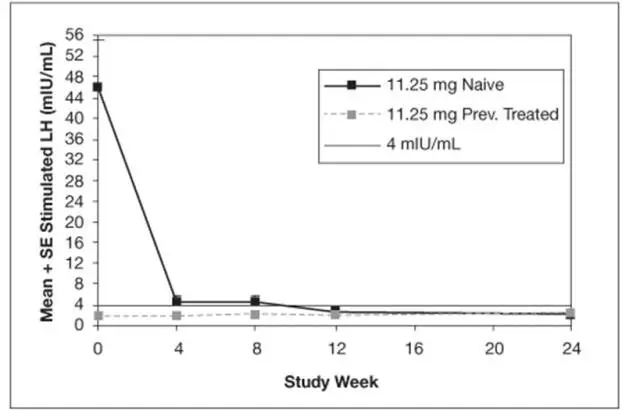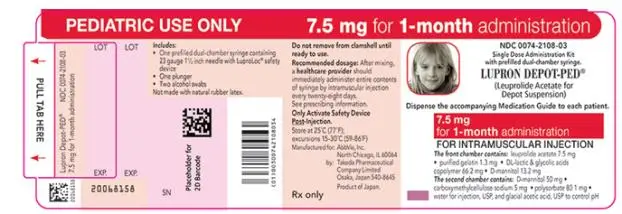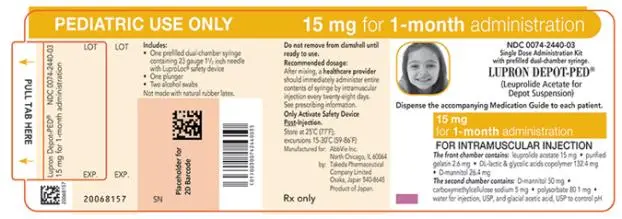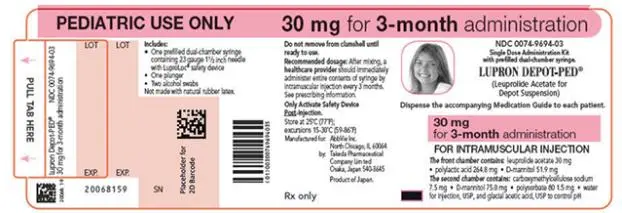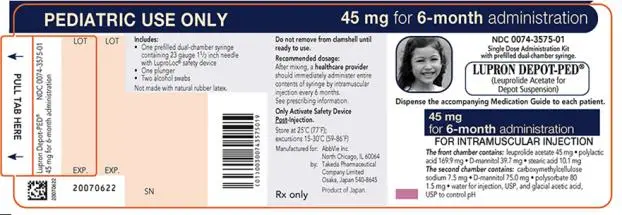Drug Detail:Lupron depot-ped (Leuprolide [ loo-proe-lide ])
Drug Class: Gonadotropin releasing hormones Hormones / antineoplastics
Highlights of Prescribing Information
LUPRON DEPOT-PED (leuprolide acetate for depot suspension), for intramuscular use
Initial U.S. Approval: 1985
Recent Major Changes
| Dosage and Administration (2.1, 2.4) | 04/2023 |
Indications and Usage for Lupron Depot-PED
LUPRON DEPOT-PED is a gonadotropin releasing hormone (GnRH) agonist indicated for the treatment of pediatric patients with central precocious puberty. (1)
Lupron Depot-PED Dosage and Administration
- Must be administered by a healthcare professional. (2.1)
- Select appropriate LUPRON DEPOT-PED syringe for the intended dosing frequency and administer intramuscularly. (2.1)
- For 1-month administration: Starting dose is 7.5, 11.25, or 15 mg based on the patient’s weight. (2.2)
- For 3-month administration: Doses are either 11.25 or 30 mg. (2.3)
- For 6-month administration: Dose is 45 mg. (2.4)
- Monitor hormonal and clinical parameters during treatment to ensure adequate suppression. (2.2, 2.3, 2.4)
- Rotate injection site periodically. (2.5)
- See Full Prescribing Information for administration and reconstitution instructions. (2.5, 2.6)
Dosage Forms and Strengths
For depot suspension: leuprolide acetate as a lyophilized powder supplied in single-dose, prefilled dual-chamber syringe with diluent (3):
- For 1-month administration: 7.5 mg, 11.25 mg, or 15 mg
- For 3-month administration: 11.25 mg or 30 mg
- For 6-month administration: 45 mg
Contraindications
- Hypersensitivity reactions to GnRH, GnRH agonists or any of the excipients in LUPRON DEPOT-PED (4)
- Pregnancy (4, 8.1)
Warnings and Precautions
-
Initial Rise of Gonadotropins and Sex Steroid Levels: During the early phase of therapy, gonadotropins and sex steroids may rise above baseline because of the initial stimulatory effect of the drug. Therefore, an increase in clinical signs and symptoms of puberty, including vaginal bleeding, may be observed during the first weeks of therapy or after subsequent doses. (5.1)
-
Psychiatric events: Have been reported in patients taking GnRH agonists. Events include emotional lability, such as crying, irritability, impatience, anger, and aggression. Monitor for development or worsening of psychiatric symptoms. (5.2)
-
Convulsions: Have been observed in patients with or without a history of seizures, epilepsy, cerebrovascular disorders, central nervous system anomalies or tumors, and in patients on concomitant medications that have been associated with convulsions. (5.3)
- Pseudotumor Cerebri (Idiopathic Intracranial Hypertension): Have been reported in pediatric patients receiving GnRH agonists, including LUPRON DEPOT-PED. Monitor patients for headache, papilledema, and blurred vision. (5.4)
Adverse Reactions/Side Effects
- Adverse events related to suppression of endogenous sex steroid secretion and injection site reactions including abscess may occur with LUPRON DEPOT-PED 7.5 mg, 11.25 mg, or 15 mg for 1-month administration. (6.1, 6.2)
- In the clinical studies for LUPRON DEPOT-PED 7.5 mg, 11.25 mg, or 15mg for 1-month administration the most common (≥2%) adverse reactions were: emotional lability, headache, general pain, acne/seborrhea, rash including erythema multiforme and vaginitis/vaginal bleeding/vaginal discharge. (6.1)
- In the clinical studies for LUPRON DEPOT-PED 11.25 mg or 30 mg for 3-month administration the most common (>2%) adverse reactions were: injection site pain, weight increased, headache, mood altered, and injection site swelling. (6.1)
- In the clinical study for LUPRON DEPOT-PED 45 mg for 6-month administration the most common (≥4%) adverse reactions were: injection site reactions, headache, psychiatric events, abdominal pain, diarrhea, hemorrhage, nausea and vomiting, pyrexia, pruritus, pain in extremity, rash, back pain, ligament sprain, weight increased, fracture, breast tenderness, insomnia, chest pain, and hyperhidrosis. (6.1)
To report SUSPECTED ADVERSE REACTIONS, contact AbbVie Inc. at 1-800-633-9110 or FDA at 1-800-FDA-1088 or www.fda.gov/medwatch
See 17 for PATIENT COUNSELING INFORMATION and Medication Guide.
Revised: 4/2023
Related/similar drugs
tamoxifen, leuprolide, triptorelin, Nolvadex, SoltamoxFull Prescribing Information
1. Indications and Usage for Lupron Depot-PED
LUPRON DEPOT-PED is indicated for the treatment of pediatric patients with central precocious puberty (CPP).
2. Lupron Depot-PED Dosage and Administration
2.1 Important Dosing Information
• LUPRON DEPOT-PED must be administered by a healthcare professional.
• Individualize the dose of LUPRON DEPOT-PED for each patient.
• Select the appropriate LUPRON-DEPOT PED syringe for the intended dosing frequency and administer intramuscularly.
• Each LUPRON DEPOT-PED strength and formulation has different release characteristics. Do not use partial syringes or a combination of syringes to achieve a particular dose.
• In the case of inadequate suppression of pituitary gonadotropins and peripheral sex steroids with a maximal dosage, consider other available gonadotropin releasing hormone (GnRH) agonists indicated for the treatment of central precocious puberty.
• Discontinue LUPRON DEPOT-PED at the appropriate age of onset of puberty.
2.2 Dosage and Recommended Monitoring for 1-Month Administration
- Administer LUPRON DEPOT-PED 7.5 mg, 11.25 mg, or 15 mg for 1-month administration as a single-dose intramuscular injection once every month.
- The starting dose is based on the patient's weight (see Table 1).
| Table 1. Dosage Recommendations Based on Body Weight for LUPRON DEPOT-PED for 1-Month Administration | |
| Body Weight | Once Monthly Recommended Dosage |
| Less than or equal to 25 kg | 7.5 mg |
| Greater than 25 kg up to 37.5 kg | 11.25 mg |
| Greater than 37.5 kg | 15 mg |
- The dosage may need to be adjusted with changes in body weight.
- If adequate hormonal and clinical suppression is not achieved with the starting dose, increase the dosage to the next available higher dose (e.g., 11.25 mg or 15 mg at the next monthly injection).
- Monitor response with a GnRH stimulation test, basal luteinizing hormone (LH) or serum concentration of sex steroid levels beginning 1 to 2 months following initiation of therapy, with changing doses, or further as judged clinically appropriate in order to confirm maintenance of efficacy.
- Assess height (for calculation of growth rate) and bone age every 6 to 12 months.
2.3 Dosage and Recommended Monitoring for 3-Month Administration
- Use LUPRON DEPOT-PED 11.25 mg or 30 mg for 3-month administration once every three months (12 weeks) as a single-dose intramuscular injection.
- Monitor response with a GnRH stimulation test, basal LH or serum concentration of sex steroid levels at months 2 to 3, month 6 and further as judged clinically appropriate, to confirm maintenance of efficacy.
- Assess height (for calculation of growth rate) and bone age every 6 to 12 months.
2.4 Dosage and Recommended Monitoring for 6-Month Administration
• Use LUPRON DEPOT-PED 45 mg for 6-month administration once every six months (24 weeks) as a single-dose intramuscular injection.
• Monitor response with a GnRH stimulation test, basal LH or serum concentration of sex steroid levels at months 5 to 6 and further as judged clinically appropriate, to confirm maintenance of efficacy.
• Assess height (for calculation of growth rate) and bone age every 6 to 12 months.
2.5 Important Administration Instructions
- Administer LUPRON DEPOT-PED as a single-dose intramuscular injection into the gluteal area, anterior thigh, or shoulder.
- Rotate injection sites within the same region from one injection to the next.
- Inject immediately after reconstitution. Discard if not used within 2 hours.
2.6 Reconstitution Instructions
1. Visually inspect the LUPRON DEPOT-PED powder and diluent. Do not use the syringe if clumping or caking is evident. A thin layer of powder on the wall of the syringe is considered normal prior to mixing with the diluent. The diluent should appear clear and free from particulate matter. Do not use the diluent if it is not clear or there is particulate matter.
2. To prepare for injection, screw the white plunger into the end stopper until the stopper begins to turn. (see Figure 1 and Figure 2)

Figure 1
LuproLoc Safety Device should be activated after product injection, refer to Step 9 (Figure 7).
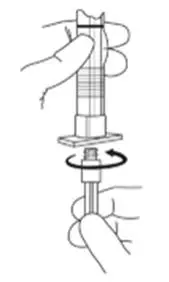
Figure 2
3. Hold the syringe upright. Release the diluent by slowly pushing the plunger for 6 to 8 seconds until the first stopper is at the blue line in the middle of the barrel. (Figure 3)
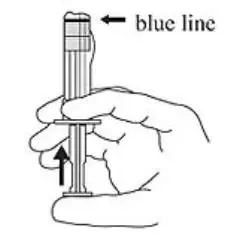
Figure 3
4. Keep the syringe upright. Mix the powder thoroughly by gently shaking the syringe until the powder forms a uniform suspension. The suspension will appear milky. If the powder adheres to the stopper or caking/clumping is present, tap the syringe with your finger to disperse. Do not use if any of the powder has not gone into suspension. (Figure 4)
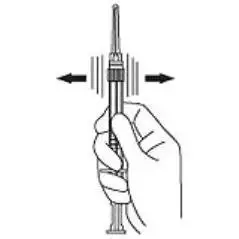
Figure 4
5. Hold the syringe upright. With the opposite hand pull the needle cap upward without twisting.
6. Keep the syringe upright. Advance the plunger to expel the air from the syringe.
Now the syringe is ready for injection.
7. After cleaning the injection site with an alcohol swab, administer the intramuscular injection by inserting the needle at a 90 degree angle into the deltoid, gluteal area, or anterior thigh. (Figure 5)
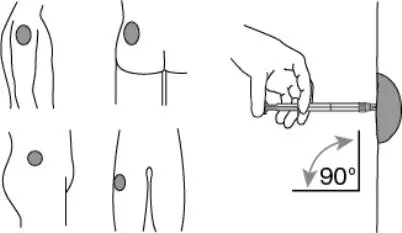
Figure 5
NOTE: Aspirated blood would be visible just below the luer lock connection if a blood vessel is accidentally penetrated. If present, blood can be seen through the transparent LuproLoc® safety device. If blood is present remove the needle immediately. Do not inject the medication. (Figure 6)
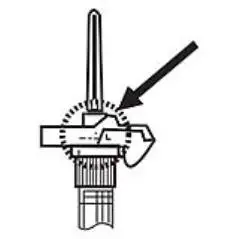
Figure 6
8. Inject the entire contents of the syringe intramuscularly immediately after reconstitution. The suspension settles very quickly following reconstitution.
9. Withdraw the needle. Once the syringe has been withdrawn, activate immediately the LuproLoc® safety device by pushing the arrow on the lock upward towards the needle tip with the thumb or finger, as illustrated, until the needle cover of the safety device is fully extended over the needle and a click is heard or felt. (Figure 7)
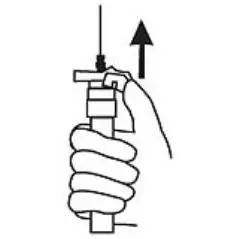
Figure 7
3. Dosage Forms and Strengths
For depot suspension: a white lyophilized powder supplied in a single-dose, prefilled dual-chamber syringe with a colorless diluent is available as:
- For 1-month administration: 7.5 mg, 11.25 mg, or 15 mg of leuprolide acetate
- For 3-month administration: 11.25 mg or 30 mg of leuprolide acetate
- For 6-month administration: 45 mg of leuprolide acetate
4. Contraindications
- Hypersensitivity to GnRH, GnRH agonists or any of the excipients in LUPRON DEPOT-PED. Anaphylactic reactions to synthetic GnRH or GnRH agonists have been reported [see Adverse Reactions (6.2)].
- Pregnancy: LUPRON DEPOT-PED may cause fetal harm [see Use in Specific Populations (8.1)].
5. Warnings and Precautions
5.1 Initial Rise of Gonadotropins and Sex Steroid Levels
During the early phase of therapy or after subsequent doses, gonadotropins and sex steroids may rise above baseline because of a transient stimulatory effect of the drug [see Clinical Pharmacology (12.2)]. Therefore, an increase in clinical signs and symptoms of puberty, including vaginal bleeding, may be observed during the first weeks of therapy or after subsequent doses [see Adverse Reactions (6)].
5.2 Psychiatric Events
Psychiatric events have been reported in patients taking GnRH agonists, including LUPRON DEPOT-PED. Postmarking reports with this class of drugs include symptoms of emotional lability, such as crying, irritability, impatience, anger and aggression. Monitor for development or worsening of psychiatric symptoms during treatment with LUPRON DEPOT-PED [see Adverse Reactions (6.2)].
5.3 Convulsions
Postmarketing reports of convulsions have been observed in patients receiving GnRH agonists, including LUPRON DEPOT-PED. These included patients with a history of seizures, epilepsy, cerebrovascular disorders, central nervous system anomalies or tumors, and patients on concomitant medications that have been associated with convulsions such as bupropion and SSRIs. Convulsions have also been reported in patients in the absence of any of the conditions mentioned above [see Adverse Reactions (6.2)].
5.4 Pseudotumor Cerebri (Idiopathic Intracranial Hypertension)
Pseudotumor cerebri (idiopathic intracranial hypertension) have been reported in pediatric patients receiving GnRH agonists, including LUPRON DEPOT-PED. Monitor patients for signs and symptoms of pseudotumor cerebri, including headache, papilledema, blurred vision, diplopia, loss of vision, pain behind the eye or pain with eye movement, tinnitus, dizziness, and nausea.
6. Adverse Reactions/Side Effects
The following serious adverse reactions are described here and elsewhere in the label:
- Initial rise in gonadotropin and sex steroid levels [see Warnings and Precautions (5.1)].
- Psychiatric Events [see Warnings and Precautions (5.2)].
- Convulsions [see Warnings and Precautions (5.3)].
- Pseudotumor Cerebri (Idiopathic Intracranial Hypertension) [see Warnings and Precautions (5.4)]
6.1 Clinical Trials Experience
Because clinical studies are conducted under widely varying conditions, adverse reaction rates observed in the clinical studies of a drug cannot be directly compared to rates in the clinical studies of another drug and may not reflect the rates observed in practice.
LUPRON DEPOT-PED for 1-month administration
LUPRON DEPOT-PED 1-month administration was evaluated in a pivotal, open label, multicenter study in which 55 (49 female and 6 male) pediatric patients with central precocious puberty were enrolled. The age ranged from 1 to 8 years of age at the beginning of treatment; the mean age for females was 6.8 years (range: 1 to 9 years) and the mean age for males was 7.5 years (range: 4 to 9 years); 61.8% were Caucasian; 20% Black; 1.8% Oriental; and 16.4% Hispanic.
Adverse reactions that occurred in ≥2% of patients are shown in Table 2.
| Table 2. Adverse Reactions Occurring in ≥2% in Pediatric Patients with CPP Receiving
LUPRON DEPOT-PED 1-month |
|
| % of Patients
(N = 421) |
|
| Injection Site Reactions Including Abscess* | 9 |
| Emotional Lability | 5 |
| Headache | 3 |
| General Pain | 3 |
| Acne/Seborrhea | 3 |
| Rash Including Erythema Multiforme | 3 |
| Vaginitis/Vaginal Bleeding/Vaginal Discharge | 3 |
| Vasodilation | 2 |
| * Most events were mild or moderate in severity. | |
Less Common Adverse Reactions
The following adverse reactions were reported in less than 2% of the patients and are listed below by body system.
Body as a Whole– aggravation of preexisting tumor and decreased vision, allergic reaction, body odor, fever, flu syndrome, hypertrophy, infection;
Cardiovascular System– bradycardia, hypertension, peripheral vascular disorder, syncope; Digestive System– constipation, dyspepsia, dysphagia, gingivitis, increased appetite, nausea/vomiting;
Endocrine System– accelerated sexual maturity, feminization, goiter;
Hemic and Lymphatic System– purpura;
Metabolic and Nutritional Disorders– growth retarded, peripheral edema, weight gain; Musculoskeletal System– arthralgia, joint disorder, myalgia, myopathy;
Nervous System– hyperkinesia, somnolence;
Psychiatric System – depression, nervousness;
Respiratory System– asthma, epistaxis, pharyngitis, rhinitis, sinusitis;
Integumentary System (Skin and Appendages)– alopecia, hair disorder, hirsutism, leukoderma, nail disorder, skin hypertrophy;
Urogenital System– cervix disorder/neoplasm, dysmenorrhea, gynecomastia/breast disorders, menstrual disorder, urinary incontinence.
Laboratory: The following laboratory events were reported as adverse reactions: antinuclear antibody present and increased sedimentation rate.
LUPRON DEPOT-PED for 3-month administration
LUPRON DEPOT-PED for 3-month administration was evaluated in a pivotal, open-label, multicenter, clinical study with 84 randomized pediatric patients with central precocious puberty; 76 (90.5%) were females and 8 (9.5%) were males. The age ranged from 1 to 11 years age at the beginning of treatment; 80/84 (95.2%) were 5 years or older, and female patients were younger than male; the mean age for 11.25 mg and 30 mg groups for females was 7.6 and 7.7 years, and for males 9.3 and 9.4 years, respectively; 58.3% were Caucasian; 22.6% were Black; 7.1% were Asian; 1.2% were Native Hawaiian or Other Pacific Islander; and 10.7% were Multi-race.
Adverse reactions that occurred in ≥2% of patients are shown in Table 3.
| Table 3. Adverse Reactions Occurring in ≥2% in Pediatric Patients with CPP
Receiving LUPRON DEPOT-PED for 3-month administration. |
|||
| %
11.25 mg every 3 Months N=42 | %
30 mg every 3 Months N=42 | %
Overall N = 84 |
|
| Injection site pain | 19 | 21 | 20 |
| Weight increased | 7 | 7 | 7 |
| Headache | 2 | 7 | 5 |
| Mood altered | 5 | 5 | 5 |
| Injection site swelling | 2 | 2 | 2 |
Less Common Adverse Reactions
The following adverse reactions were reported in one patient and are listed below by system organ class:
Gastrointestinal Disorders– abdominal pain, nausea;
General Disorders and Administration Site Conditions– asthenia, gait disturbance, injection site abscess sterile, injection site hematoma, injection site induration, injection site warmth, irritability;
Metabolic and Nutritional Disorders– decreased appetite, obesity;
Musculoskeletal and Connective Tissue Disorders - musculoskeletal pain, pain in extremity; Nervous System Disorders– dizziness;
Psychiatric Disorders– crying, tearfulness;
Respiratory, Thoracic and Mediastinal Disorders– cough;
Skin and Subcutaneous Tissue Disorders– hyperhidrosis;
Vascular Disorders– pallor.
LUPRON DEPOT-PED for 6-month administration
LUPRON DEPOT-PED for 6-month administration was evaluated in an open-label, multicenter, clinical study with 45 pediatric patients with central precocious puberty; 41 (91%) were females and 4 (9%) were males. The baseline age ranged from 4 to 10 years. There were 30 (67%) Caucasian; 7 (16%) Black; and 1 (2%) Asian.
Adverse reactions that occurred in ≥4% of all patients are shown in Table 4.
| Table 4. Adverse Reactions Occurring in ≥4% in Pediatric Patients with CPP
Receiving LUPRON DEPOT-PED for 6-month administration. |
|
| Total
(N = 45) n (%) |
|
| Injection Site Reactions a | 35 (78%) |
| Headache b | 15 (33%) |
| Psychiatric Events c | 10 (22%) |
| Abdominal Pain d | 8 (18%) |
| Diarrhea e | 7 (16%) |
| Hemorrhage f | 6 (13%) |
| Nausea and Vomiting | 6 (13%) |
| Pyrexia | 6 (13%) |
| Pruritus g | 5 (11%) |
| Pain in extremity | 4 (9%) |
| Rash | 3 (7%) |
| Back Pain | 3 (7%) |
| Ligament sprain | 3 (7%) |
| Weight increased | 3 (7%) |
| Fracture h | 2 (4%) |
| Breast tenderness i | 2 (4%) |
| Insomnia j | 2 (4%) |
| Chest pain | 2 (4%) |
| Hyperhidrosis | 2 (4%) |
| a Injection site reactions includes the preferred terms injection site pain, injection site erythema, injection site reaction, injection site warmth, injection site bruising, injection site discomfort, and injection site swelling b-Headache includes the preferred terms headache and cluster headache c Psychiatric events includes the preferred terms affect lability, affective disorder, aggression, crying, depressed mood, disruptive mood dysregulation disorder, hallucination auditory, mood altered, mood swings, and trichotillomania d Abdominal pain includes the preferred terms abdominal pain, abdominal pain upper, and abdominal discomfort e Diarrhea includes the preferred terms gastroenteritis and diarrhea f Hemorrhage includes the preferred terms contusion, epistaxis, hematochezia, and injection site bruising g Pruritus includes the preferred terms pruritus, vulvovaginal pruritus, nasal pruritus h Fracture includes the preferred terms ankle fracture and tibia fracture i Breast tenderness includes the preferred terms breast pain and breast tenderness j Insomnia includes the preferred terms initial insomnia and insomnia |
|
6.2 Postmarketing Experience
The following adverse reactions have been identified during post-approval use of leuprolide acetate or LUPRON DEPOT-PED in pediatric patients. Because these reactions are reported voluntarily from a population of uncertain size, it is not always possible to reliably estimate their frequency or establish a causal relationship to drug exposure.
Allergic reactions: anaphylactic, rash, urticaria, and photosensitivity reactions.
General: chest pain, weight increase, decreased appetite, fatigue.
Laboratory Abnormalities: decreased WBC.
Metabolic: diabetes mellitus.
Musculoskeletal and Connective Tissue: tenosynovitis-like symptoms, severe muscle pain, arthralgia, epiphysiolysis, muscle spasms, myalgia.
Published literature and postmarketing reports indicate that bone mineral density may decrease during GnRH therapy in pediatric patients with central precocious puberty. Published studies indicate that after discontinuation of therapy, subsequent bone mass accrual is preserved and peak bone mass in late adolescence does not seem to be affected.
Neurologic: neuropathy peripheral, convulsion, insomnia, pseudotumor cerebri (idiopathic intracranial hypertension).
Psychiatric Disorders: emotional lability, such as crying, irritability, impatience, anger, and aggression. Depression, including rare reports of suicidal ideation and attempt. Many, but not all, of these patients had a history of psychiatric illness or other comorbidities with an increased risk of depression.
Reproductive System: vaginal bleeding, breast enlargement.
Respiratory: dyspnea.
Skin and Subcutaneous Tissue: injection site reactions including induration and abscess, flushing, hyperhidrosis.
Vascular Disorders: hypertension, hypotension.
8. Use In Specific Populations
8.1 Pregnancy
Risk Summary
LUPRON DEPOT-PED is contraindicated in pregnancy [see Contraindications (4)].
LUPRON DEPOT-PED may cause fetal harm, when administered to a pregnant woman, based on findings from animal studies and the drug’s mechanism of action [see Clinical Pharmacology (12.1)]. The available data from published clinical studies and case reports and from the pharmacovigilance database on exposure to LUPRON DEPOT-PED during pregnancy are insufficient to assess the risk of major birth defects, miscarriage, or adverse maternal or fetal outcomes. Based on animal reproduction studies, LUPRON DEPOT-PED may be associated with an increased risk of pregnancy complications, including early pregnancy loss and fetal harm. In animal reproduction studies, subcutaneous administration of leuprolide acetate to rabbits during the period of organogenesis caused embryo-fetal toxicity, decreased fetal weights and a dose-dependent increase in major fetal abnormalities in animals at doses less than the recommended human dose based on body surface area using an estimated daily dose. A similar rat study also showed increased fetal mortality and decreased fetal weights but no major fetal abnormalities at doses less than the recommended human dose based on body surface area using an estimated daily dose (see Data).
The estimated background risk of major birth defects and miscarriage for the indicated population is unknown. In the US general population, the estimated background risk of major birth defects and miscarriage in clinically recognized pregnancies is 2% - 4% and 15% -20%, respectively.
Data
Animal Data
When administered on day 6 of pregnancy at test dosages of 0.00024 mg/kg, 0.0024 mg/kg, and 0.024 mg/kg (doses less than the recommended human dose) to rabbits, leuprolide acetate produced a dose-related increase in malformations comprised primarily of segmental and fusion defects of the skeleton and skull. Similar studies in rats failed to demonstrate an increase in fetal malformations. There was increased fetal mortality and decreased fetal weights with the two higher doses of leuprolide acetate in rabbits and with the highest dose (0.024 mg/kg) in rats.
12. Lupron Depot-PED - Clinical Pharmacology
12.1 Mechanism of Action
Leuprolide acetate, a GnRH agonist, acts as a potent inhibitor of gonadotropin secretion (LH and follicle stimulating hormone (FSH)) when given continuously in therapeutic doses.
12.2 Pharmacodynamics
Following an initial stimulation of GnRH receptors, chronic administration of leuprolide acetate results in downregulation of GnRH receptors, reduction in release of LH and FSH, and consequent suppression of ovarian and testicular production of estradiol and testosterone, respectively. This inhibitory effect is reversible upon discontinuation of drug therapy.
12.3 Pharmacokinetics
Absorption
LUPRON DEPOT-PED for 1-month administration
Following a single LUPRON DEPOT-PED 7.5 mg for 1-month administration to adult patients, mean peak leuprolide plasma concentration was almost 20 ng/mL at 4 hours and then declined to 0.36 ng/mL at 4 weeks. However, intact leuprolide and an inactive major metabolite could not be distinguished by the assay which was employed in the study. Nondetectable leuprolide plasma concentrations have been observed during chronic LUPRON DEPOT-PED 7.5 mg administration, but testosterone levels appear to be maintained at castrate levels.
In a study of pediatric patients with CPP, doses of 7.5 mg, 11.25 mg and 15.0 mg of LUPRON DEPOT-PED were given every 4 weeks. In 22 pediatric patients, trough leuprolide plasma levels were determined according to weight categories as summarized below:
| Patient Weight
Range (kg) | Group Weight
Average (kg) | Dose (mg) | Trough Plasma Leuprolide Level
Mean ±SD (ng/mL)* |
| 20.2 - 27.0 | 22.7 | 7.5 | 0.77±0.033 |
| 28.4 - 36.8 | 32.5 | 11.25 | 1.25±1.06 |
| 39.3 - 57.5 | 44.2 | 15.0 | 1.59±0.65 |
| * Group average values determined at Week 4 immediately prior to leuprolide injection. Drug levels at 12 and 24 weeks were similar to respective 4 week levels. | |||
LUPRON DEPOT-PED for 3-month administration
Following a single LUPRON DEPOT-PED 11.25 mg or 30 mg for 3-month administration to pediatric patients with CPP, leuprolide concentrations increased with increasing dose with mean peak leuprolide plasma concentration of 19.1 and 52.5 ng/mL at 1 hour for the 11.25 and 30 mg dose levels, respectively. The concentrations then declined to 0.08 and 0.25 ng/mL at 2 weeks after dosing for the 11.25 and 30 mg dose levels. Mean leuprolide plasma concentration remained constant from month 1 to month 3 for both 11.25 and 30 mg doses. The mean leuprolide concentrations 3 months after the first and second injections were similar indicating no accumulation of leuprolide from repeated administration.
LUPRON DEPOT-PED for 6-month administration
Following a single injection of LUPRON DEPOT-PED 45 mg for 6-month administration in 20 pediatric patients with CPP, mean peak plasma concentration increased rapidly to 15.7 ng/mL 1 hour post-dose. Following the initial rise, mean leuprolide plasma concentration declined to 0.03 ng/mL by Week 24. The mean leuprolide concentrations 6 months after the first and second injections were comparable indicating no accumulation of leuprolide from repeated administration.
Distribution
The mean steady-state volume of distribution of leuprolide following intravenous bolus administration to healthy male subjects was 27 L. In vitro binding to human plasma proteins ranged from 43% to 49%.
Elimination
Metabolism
In healthy male subjects given an intravenous 1 mg bolus of leuprolide the mean systemic clearance was 7.6 L/h, with a terminal elimination half-life of approximately 3 hours based on a two-compartment model.
In rats and dogs, administration of 14C-labeled leuprolide was shown to be metabolized to smaller inactive peptides; a pentapeptide (Metabolite I), tripeptides (Metabolites II and III) and a dipeptide (Metabolite IV). These fragments may be further catabolized.
The major metabolite (M-I) plasma concentrations measured in 5 prostate cancer patients reached maximum concentration 2 to 6 hours after dosing and were approximately 6% of the peak parent drug concentration. One week after dosing, mean plasma M-I concentrations were approximately 20% of mean leuprolide concentrations.
Excretion
Following administration of LUPRON DEPOT 3.75 mg to 3 patients, less than 5% of the dose was recovered as parent and M-I metabolite in the urine.
Specific Populations
The pharmacokinetics of LUPRON DEPOT-PED has not been determined in patients with hepatic or renal impairment.
Drug-Drug Interactions
No pharmacokinetic-based drug-drug interaction studies have been conducted with LUPRON DEPOT-PED. Leuprolide acetate is a peptide that is not degraded by cytochrome P-450 enzymes; hence, drug interactions associated with cytochrome P-450 enzymes would not be expected to occur.
Medication Guide
| MEDICATION GUIDE
LUPRON DEPOT-PED® (loo-pron depo peed) (leuprolide acetate for depot suspension) |
||||
What is the most important information I should know about LUPRON DEPOT-PED?
|
||||
| ◦ headache ◦ eye problems, including blurred vision, double vision and decreased eyesight ◦ eye pain | ◦ ringing in the ears ◦ dizziness ◦ nausea |
|||
What is LUPRON DEPOT-PED?
|
||||
LUPRON DEPOT-PED should not be taken if your child is:
|
||||
Before your child receives LUPRON DEPOT-PED, tell their doctor about all of your child’s medical conditions including if they:
|
||||
How will your child receive LUPRON DEPOT-PED?
|
||||
| What are the possible side effects of LUPRON DEPOT-PED?
LUPRON DEPOT-PED may cause serious side effects. See “What is the most important information I should know about LUPRON DEPOT-PED?” The most common side effects of LUPRON DEPOT-PED received 1 time each month include:
|
||||
|
|
|
||
|
These are not all the possible side effects of LUPRON DEPOT-PED. Call your doctor for medical advice about side effects. You may report side effects to FDA at 1-800-FDA-1088. |
||||
How should I store LUPRON DEPOT-PED INJECTION?
|
||||
| General information about the safe and effective use of LUPRON DEPOT-PED.
Medicines are sometimes prescribed for purposes other than those listed in a Medication Guide. Do not use LUPRON DEPOT-PED for a condition for which it was not prescribed. This Medication Guide summarizes the most important information about LUPRON DEPOT-PED. If you would like more information, talk with your doctor. You can ask your pharmacist or doctor for information about LUPRON DEPOT-PED that is written for doctors or trained nurses. |
||||
| What are the ingredients in LUPRON DEPOT-PED?
LUPRON DEPOT-PED 7.5 mg, 11.25 mg or 15 mg for 1-month administration: Active Ingredients: leuprolide acetate for depot suspension Inactive Ingredients: purified gelatin, DL-lactic and glycolic acids copolymer, D-mannitol, carboxymethylcellulose sodium, polysorbate 80, water for injection, USP, and glacial acetic acid, USP to control pH. LUPRON DEPOT-PED 11.25 mg or 30 mg for 3-month administration: Active Ingredients: leuprolide acetate for depot suspension Inactive Ingredients: polylactic acid, D-mannitol, carboxymethylcellulose sodium, polysorbate 80, water for injection, USP, and glacial acetic acid, USP to control pH. LUPRON DEPOT-PED 45 mg for 6-month administration: Active Ingredients: leuprolide acetate for depot suspension Inactive Ingredients: polylactic acid, D-mannitol, and stearic acid, carboxymethylcellulose sodium, D-mannitol, polysorbate 80, water for injection, USP, and glacial acetic acid, USP to control pH. Manufactured for: AbbVie Inc. North Chicago, IL 60064 By Takeda Pharmaceutical Company Limited Osaka, Japan 540-8645 For more information, go to www.lupronped.com or call 1-800-633-9110. |
||||
| This Medication Guide has been approved by the U.S. Food and Drug Administration. | Revised: April, 2023 | |||
20078685
| LUPRON DEPOT-PED
leuprolide acetate kit |
||||||||||||||||
|
||||||||||||||||
|
||||||||||||||||
|
||||||||||||||||
|
||||||||||||||||
|
||||||||||||||||
|
||||||||||||||||
|
||||||||||||||||
|
||||||||||||||||
|
||||||||||||||||
|
||||||||||||||||
|
||||||||||||||||
|
||||||||||||||||
|
||||||||||||||||
|
||||||||||||||||
|
||||||||||||||||
| LUPRON DEPOT-PED
leuprolide acetate kit |
||||||||||||||||
|
||||||||||||||||
|
||||||||||||||||
|
||||||||||||||||
|
||||||||||||||||
|
||||||||||||||||
|
||||||||||||||||
|
||||||||||||||||
|
||||||||||||||||
|
||||||||||||||||
|
||||||||||||||||
|
||||||||||||||||
|
||||||||||||||||
|
||||||||||||||||
|
||||||||||||||||
|
||||||||||||||||
| LUPRON DEPOT-PED
leuprolide acetate kit |
||||||||||||||||
|
||||||||||||||||
|
||||||||||||||||
|
||||||||||||||||
|
||||||||||||||||
|
||||||||||||||||
|
||||||||||||||||
|
||||||||||||||||
|
||||||||||||||||
|
||||||||||||||||
|
||||||||||||||||
|
||||||||||||||||
|
||||||||||||||||
|
||||||||||||||||
|
||||||||||||||||
|
||||||||||||||||
| LUPRON DEPOT-PED
leuprolide acetate kit |
||||||||||||||||
|
||||||||||||||||
|
||||||||||||||||
|
||||||||||||||||
|
||||||||||||||||
|
||||||||||||||||
|
||||||||||||||||
|
||||||||||||||||
|
||||||||||||||||
|
||||||||||||||||
|
||||||||||||||||
|
||||||||||||||||
|
||||||||||||||||
|
||||||||||||||||
|
||||||||||||||||
|
||||||||||||||||
| LUPRON DEPOT-PED
leuprolide acetate kit |
|||||||||||||||
|
|||||||||||||||
|
|||||||||||||||
|
|||||||||||||||
|
|||||||||||||||
|
|||||||||||||||
|
|||||||||||||||
|
|||||||||||||||
|
|||||||||||||||
|
|||||||||||||||
|
|||||||||||||||
|
|||||||||||||||
|
|||||||||||||||
|
|||||||||||||||
|
|||||||||||||||
|
|||||||||||||||
| LUPRON DEPOT-PED
leuprolide acetate kit |
||||||||||||||||||
|
||||||||||||||||||
|
||||||||||||||||||
|
||||||||||||||||||
|
||||||||||||||||||
|
||||||||||||||||||
|
||||||||||||||||||
|
||||||||||||||||||
|
||||||||||||||||||
|
||||||||||||||||||
|
||||||||||||||||||
|
||||||||||||||||||
|
||||||||||||||||||
|
||||||||||||||||||
|
||||||||||||||||||
|
||||||||||||||||||
| Labeler - AbbVie Inc. (078458370) |





